Memorial Day . . . a day of remembrance
Memorial Day has always been a day of remembrance for my family because we’ve had several family members who were in the military. My great aunt, Ila Armsbury, my dad and all my uncles fought in WWII. My cousin, Mike L., was in the Navy as was my brother, Bill. My cousins, John H. and Jim R., were career men in the Air Force. Bill is still actively involved with the VA, and Jim is the State Inspector for the Kansas chapter of the VFW. Because of the emphasis my grandparents put on Memorial Day, I have fond memories of those celebrations from my childhood.
From the time I was very young, I accompanied my grandparents when they took flowers from Grammy’s garden – huge, fragrant, floppy-headed pink peonies and deep purple iris – to the Lincoln, Kansas, cemetery to put on the graves of deceased loved ones.
Afterwards we drove to Osborne County, Kansas, to the Cheyenne Cemetery and then the Delhi Cemetery, where many of our ancestors were buried.
The Cheyenne Country Cemetery
My great great great grandfather, Nazair Mason, is buried at the Cheyenne Cemetery. He died long before I was born but I heard stories about him. He was a feisty little man who emigrated to Illinois from Quebec, served with Company K of the 4th Illinois Cavalry during the Civil War, and then moved to Kansas afterwards. According to my grandmother, Wava Farrington, as an old man, when Grandpa Mason got angry he pounded his cane on the floor and swore in French. Below are two photos, one of young Nazair Mason in his cavalry uniform. The handwritten inscription below his picture reads: Nazair Mason, Kanakee City Illinois – Joined G. A. R. (Grand Army of the Rebpulic) service Civil War. The other photo is of his grave stone at the Cheyenne country cemetery in Osborne County, Kansas.
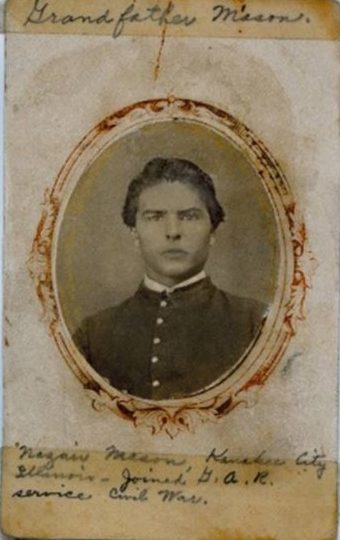

Delhi Country Cemetery
I don’t recall our trips to Cheyenne, probably because we just drove there to put flowers on the family graves. But after our brief stop at Cheyenne, we headed out to Delhi (pronounced Del Hi) where the big celebrations were held. Below is a photo of the entrance to the cemetery. The photo was taken in the mid-1990’s. The Delhi Country Church was torn down some years before that. The church, a white clapboard one-story building, was at the back of the property behind the cedar trees on the left side of the photo.
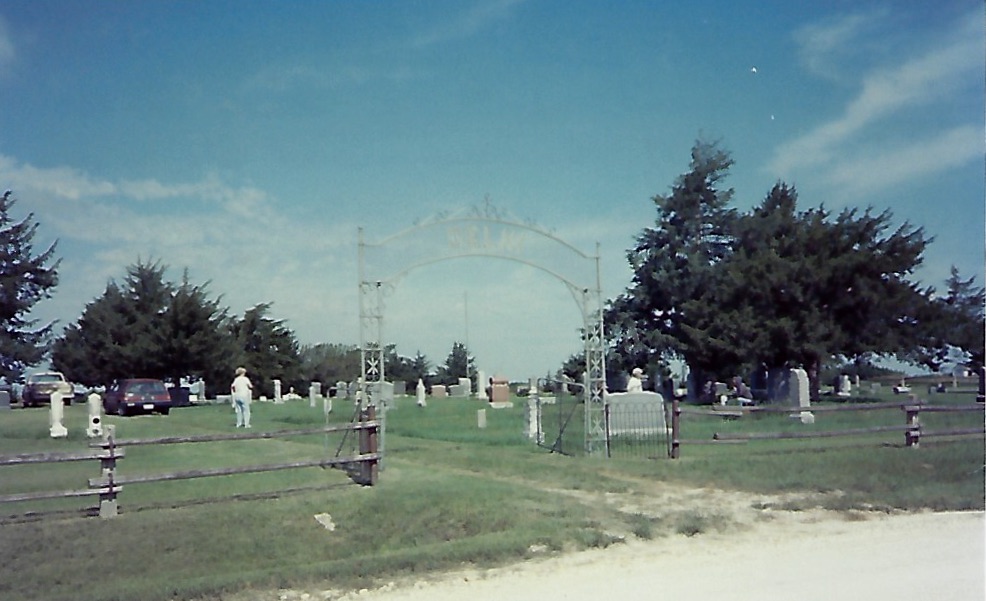
Memorial Day, May 1951
The Memorial Day Celebration at Delhi included a morning church service, a huge and delicious potluck meal, and an afternoon program of patriotic songs and other types of entertainment. My first Memorial Day celebration at Delhi was May, 1951, at the age of 10 months. Below is a photo showing my family eating lunch before the afternoon’s entertainment. Obviously I don’t remember that year’s event, but I do remember later ones.
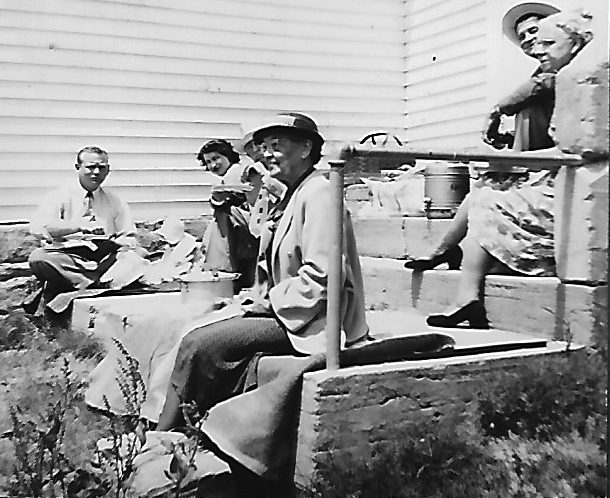
My great, great grandmother, Rosena Armsbury, is seated at the front, closest to the camera. Behind her are my great grandparents, Ira and Florence Armsbury. Behind Rosena and barely visible is my grandfather, Nolan Farrington. Behind him is my mom, LaDonna Burke. I’m the baby in the white bonnet. My face isn’t visible. Next to me is my dad, Lloyd Burke.
Performing at Delhi
My grandparents, Wava and Nolan Farrington, always performed at Delhi. I remember them singing a duet, but the most amazing part was that Grampy yodeled, a talent he developed in the 1930s when he and my grandma, Wava, tried to break into radio with a show that included humorous skits, music, and yodeling. I still remember my astonishment when I heard Grandpa yodel. How I wish I could hear that one more time!
Delhi Cemetery plays an important role in my book, Ila’s War. Below is an excerpt from the book which is told from Ila’s perspective at the end of her life. The setting is Decoration Day, 1920. The Armsbury family, Ira, Florence, Wava, age 11; Metta, age 8; and Ila, age 4 have just arrived at Delhi.
Memorial Day at Delhi, 1920 — an excerpt from Ila’s War
Our family attended the Decoration Day celebration every year because Daddy’s grandpa, Nazier Mason, a respected farmer in the area, was a Civil War veteran who’d served with the 4th Illinois Cavalry. There weren’t many Civil War veterans still alive by 1920, so folks always gave Grandpa Mason a big hand when he appeared at the cemetery wearing his Civil War uniform which still fit his trim figure.
And this year was especially important to Daddy because his only brother, Uncle Dwight, who had served briefly in WWI, would be present. Uncle Dwight registered for the draft in September of 1918 and joined the Army on October 1 but the armistice was signed on November 11, 1918 which quickly ended Uncle Dwight’s military career a month later. Daddy was, nevertheless, very patriotic and inordinately proud of Uncle Dwight for his willingness to serve his country, especially since Daddy had signed up during the first registration period in June, 1917, but couldn’t join the military because he was already married with three children. . . .
The front double doors of the church were propped wide open and the milky white-paned windows that ran the length of each side of the church were open to let in the breeze and the occasional bee or fly. The front pews on both sides were already full so we sat towards the back.
It was the usual type of service you saw in a small country church in 1920. The minister stood to welcome us, gave a brief prayer, and led us in a hymn while the little pump organ at the front accompanied the congregation. Prayers, scripture readings, and a sermon followed. I was squirming by that time because all I could think about was the delicious food and playing outside. Finally the word I’d been waiting for . . . “Amen.”
The church yard had been transformed in the short time we were inside. Tables made of boards resting on hay bales had been erected in the shade on the east side of the church, and a few women were already laying out platters of fried chicken, bowls of potato salad, baskets of bread and biscuits while others were rounding up their children or spreading blankets on the ground under the big cedar trees. Several ice cream freezers, many covered with newspapers, were sitting in the deep shade provided by the church building.
The picnic was followed by a rest period, designed to help us digest the huge meals we’d eaten. Some folks sat quietly on their blankets, visiting with friends and neighbors, while others took cat naps. After a brief rest, older boys and men played baseball, younger children played tag or hide-and-seek, while the women sat in small groups visiting, some doing knitting, crochet, or embroidery as they talked.
Around 4:00 P.M. folks started meandering toward the church for the next event, the afternoon’s entertainment which consisted of a few musical performances by attendees, and sometimes a skit or two, and a group sing-a-long. Mother was always reluctant to attend or to let us girls watch because she said music that made you want to dance was one of Satan’s tools. But Mother surprised us this year by allowing us to stay — a decision she later regretted. We all trooped into the church and sat down in a pew about halfway from the back.
A man I didn’t know stood at the front, holding a piece of paper. After brief introductions and a hearty welcome the program began. One performer sang a solo while another accompanied himself and played the pump organ. The audience gave rounds of applause after each selection. My eyebrows shot up when the MC stood and said, “Now, Ira Armsbury’s going to serenade us all with his harmonica. Irie, what you gonna play?”
Daddy hadn’t said a word to us. We girls grinned at each other as he stood and walked toward the front. Mother didn’t look happy but there was nothing she could do except sit, a weak and puny smile on her thin, clenched lips.
Daddy answered as he stepped up onto the platform. “Well, seems fitting to me that we mark this Decoration Day with some patriotic music, ‘specially since so many of the folks here round had loved ones that fought in the war.” Heads nodded and you could hear murmurs of “that’s right” or “my boy was one.”
“Wish I coulda gone, too, but the government thought I was too old, I guess, so I stayed behind. But every day I said a prayer for our country and all our brave boys who went over there.” Daddy paused for a moment, then he said, “How ‘bout I play that? Over There? You can sing along if you want.”
Daddy removed his Hohner harmonica box from his front shirt pocket, carefully opened the box and pulled out the small silver harmonica. He looked at it for a moment, wiped an invisible spot off of it with his shirt front, and put the harmonica to his mouth. That harmonica was only four inches long but when Daddy filled his lungs with air and blew, you could hear him all the way to Christmas.
It was easy to see why some women acted giddy around my dad, since he looked so handsome up on the stage, his beautiful and intense blue eyes twinkling as he played.
So Daddy belted out that great patriotic song amid the sound of some folks singing, some clapping, and some stomping their feet. Afterwards he got a standing ovation and beamed all the way back to his seat.
Ila’s War — an update
My original plan was to have the book in print and available to the public before Memorial Week-end, 2020. I had even begun arranging some book readings and signings when the coronavirus hit the shores of America and my plans were destroyed.
The new plan is to issue the e-book version of Ila’s War within the next couple of months, and the print book, both hardback and paperback, by the end of the year with book readings and signings to follow. I have several artifacts from my family that I will bring with me to public readings. I hope seeing some of those family items will provide readers with a real sense of the times and my family, especially Ila Armsbury. To read another excerpt from Ila’s War, or to learn more about the book, go to http://www.cindyentriken.com
Stay tuned. I’ll tell you more when I know more!
^https://www.history.com/topics/holidays/memorial-day-history#section_2

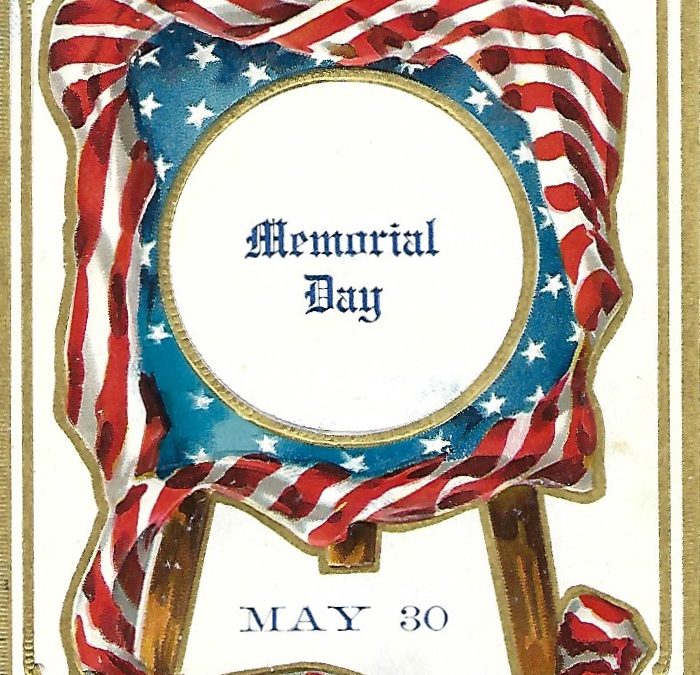
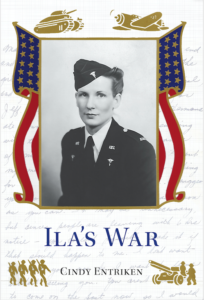
Cindy,
I found your blog quite by accident. I was searching for some information on Hundertmark’s store. My second husband Delbert Bryan’s mother was a Mason, her maiden name was Hundertmark. She was the daughter of George Oliver Mason and Emma Hundertmark. My First husband, John Ray Meili’s aunt was married to Charles Hundertmark. Your excerpt from Ila’s War caught my eye. What an interesting story, I had never heard of the KKK being active in Lincoln County. I certainly will be looking forward to seeing more of your blog.
Janice, thanks so much for writing me. By the time I was born in 1950 Mr. (George) and Mrs. Hundertmark had moved from the north end of town to across the alley from my folks’ home. Mr. Hundertmark was already dead, but Mrs. Hundertmark was alive. I vaguely remember going across the alley to visit Mrs. Hundertmark. She was a very kind elderly lady. I’ve been told that after she died someone cleaned out the house, to prepare it for sale I think. Anyway a very large stash of KKK material was in the attic of the home, and that material was burned to destroy it. The surviving family members were not supporters of the Klan and wanted that stuff gone.
I’ll add your name and email address to my blog so that you will receive notification when a new one comes out. Thanks again for writing. Best Regards.
Hello, I think we may be related. I am researching my ancestor Nazair Mason. I have found 2 gravestones for him. A military gravestone that you have featured here, and one with his wife. My problem is that they list 2 different but similar birthdays (Jun vs Jan, same year and date) and similar but different death days (sep 9th vs sep 28th, same year). The similarities are causing me to think it’s the same person and not just 2 people with the same name. Any other info you have about him would be so helpful for me and any help is appreciated.
Here is a link to the photo of his gravestone with his wife.
https://mediasvc.ancestry.com/v2/image/namespaces/1093/media/9a15af01-0931-413c-b7ed-eaa1d972999f.jpg?client=trees-mediaservice&imageQuality=hq&maxWidth=1899&maxHeight=832
Yes, Ashley, we are related! That is the headstone for my great, great, great grandparents. Are we related through the Masons or through the Schencks? I have partially drawn family trees I can share with you. Do you have photos? I have some that I can also share? I also have a copy of Nazair Mason’s obit. According to it he was born June 12, 1840 in Quebec. I know only a few stories about him. I have been to the cemetery where he and Rosena are buried. Rosena didn’t die until I was 13 so I remember her. I’m so thrilled you wrote. Thank you for taking the time. Best Regards.
Hi Cindy,
I am also related but through Nolan’s mother’s side of the family. (Chard) I have been to the Delhi Cem. and Cheyenne Cemetery before, doing family research. My Grandpa Chard’s sister is buried in the Cheyenne Cem. My brother purchased your book, Ila’s War for me and I really enjoyed it. I did however find one minor mistake. According to your book, Wava and Nolan married in Russell. I have a copy of the marriage license and they were married in Lincoln by the Probate Judge with the consent of Ira. I think I remember your grandmother. I believe I might have been her paper carrier for a few years. But, I am not sure I know which house was hers on Yauger St. We lived on the west end of Yauger for a number of years. Thank you for writing the book!
Oh my gosh! I am so delighted to hear from someone from Grampy’s side of the family. I’ve tried for years to find descendants from that side. The only ones I know are my cousin, Jan Graves, and her sister, Carolyn. The other two siblings died some years ago. Jan is my age, but all the others are or were quite a bit older so I didn’t know them well. However, Jan and I grew up together. Jan’s mom, Dolly, was a cousin to Grandpa, I think. I have the 1933 Be Neighborly Quilt with Mary Jane Farrington and others’ names embroidered on it. I would love to see a copy of Grammy and Grampy’s wedding license. I didn’t realize my error. My sources were a great aunt and another cousin. I also have the beautiful mirror and set of drawers that Louisa Chard brought to Kansas from Ohio (?) in a covered wagon. And I have one piece of cut work with embroidery done by Louisa when she was a girl. I will email you a photo of that. I am so delighted that you wrote me. Thank you so very much!